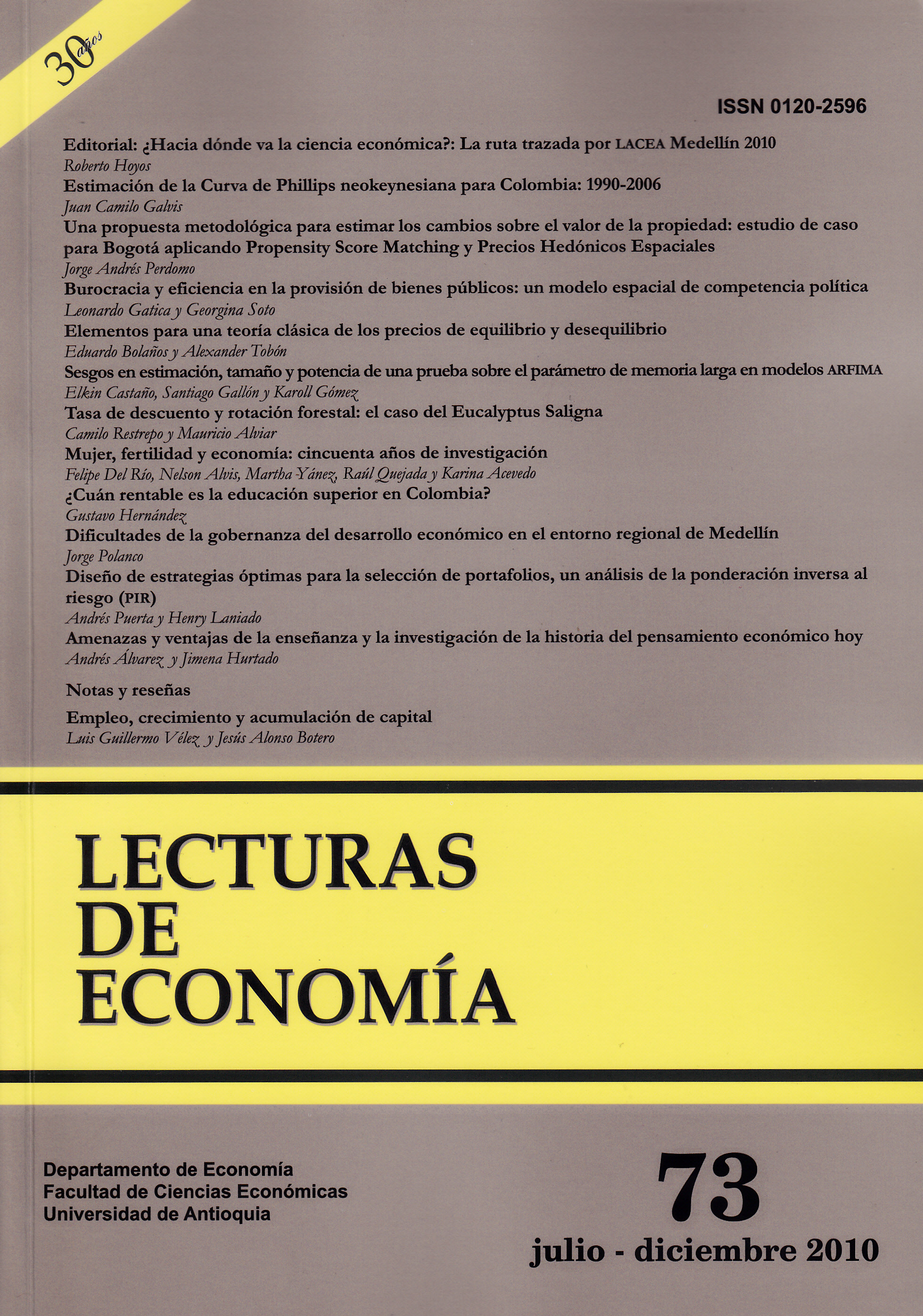A Propensity Score Matching and Spatial Hedonic Prices Approach for Estimating Property Value Fluctuations in Bogotá
DOI:
https://doi.org/10.17533/udea.le.n73a7864Keywords:
Impact evaluation, Propensity Score Matching, Spatial Hedonic Prices, property value fluctuations, TransMilenioAbstract
The aim of this study is to analyze and compare the results from Propensity Score Matching (PSM) and Spatial Hedonic Prices (SHP) methodologies estimating value fluctuations on residential proprieties in Bogotá (Colombia). Specifically, this study examines value fluctuations on residential properties nearby stations of the Bus Rapid Transit (BRT) system—Transmilenio—. The PSM and SHP approaches suggest additional value increases for residential properties close to BRT stations.
Downloads
References
Anselin, Luc (1980). “Estimation Methods for Spatial Autorregresive Structures”, Regional Science, Dissertation and Monograhs Series, 8, Cornell University, Ithaca NY.
Batt, H. W (2001). “Value Capture as a Policy Tool in Transport Economics. An Exploration in Public Finance in the Tradition of Henry George”, American Journal of Economics and Sociology, Vol. 6, No. 1, pp. 195-228.
Haab, Timothy y Kennet, McConnell (2002). Valuing Environmental and Natural Resources: The Econometrics of Non Market Valuation, Northampton, Edward Elgar Publishing.
Heckman, James; Hidehiko, Ichimura y Petra, Todd (1997). “Matching as an Econometric Evaluation Estimator: Evidence for Evaluating a Job Training Programme”, The Review of Economics Studies, Vol. 64, No. 4, pp. 605-654.
McMillen, Daniel y McDonald, John (2002). “Land Values in a Newly Zoned City”, The Review of Economic and Statistic, Vol. 84, No. 1, pp. 62-72.
Mendieta, Juan y Perdomo Calvo, Jorge Andrés (2007). “Especificación y estimación de un modelo de precios hedónico espacial para evaluar el impacto de Transmilenio sobre el valor de la propiedad en Bogotá”, Documentos CEDE, julio 2010, No. 22.
Mendoza, Camilo (2005). Value Capture for Funding Colombian BRTS Infrastructure: The Case of TransMilenio in Bogotá, M.Sc diss. Erasmus University.
Perdomo Calvo, Jorge Andrés; Mendoza, Camilo; Mendieta, Juan Carlos y Baquero, Andrés (2007). Study of the Effect of the TransMilenio Mass Transit Project on the Value of Properties in Bogotá, Colombia, Cambridge, MA, Lincoln Institute of Land Policy, WP07CA1.
Perdomo Calvo, Jorge Andrés; Castañeda, Hasbleidy y Mendieta, Juan (2010). “Evaluación de impacto del sistema de transporte masivo TransMilenio sobre el tiempo total de desplazamiento de los usuarios del transporte público tradicional”, Documentos CEDE, abril 2010, No. 11.
Rodríguez, Daniel y Mojica, Carlos (2008). Land Value Impacts of Bus: The Case of Bogotá’s TransMilenio, Cambridge, MA, Lincoln Institute of Land Policy, WP08-04.
Rodríguez, Daniel y Targa, Felipe (2004). “Value of accesibility to Bogota’s Bus Rapid Transit System”, Transport Reviews, Vol. 24, No. 5, pp. 587-610.
Rosales, Ramón; Perdomo Calvo, Jorge Andrés; Morales, Carlos y Urrego, Alejandro (2010). “Fundamentos de econometría intermedia: teoría y aplicaciones”, Documentos CEDE, enero 2010, No. 1.
Rosen, Sherwin (1974). “Hedonic Prices and Implicit Markets: Product Differentiation in Pure Competition”, Journal of Political Economy, Vol. 82, No. 1, pp. 34-55.
Vinha, Katja (2005). The Impact of the Washington Metro on Development Patterns. PhD diss. University of Maryland.
World Bank (2002). “Cities on the Move: A World Bank Urban Transport Strategy Review”. Ed. Gwilliam, K., The World Bank, Washington D.C.
Published
How to Cite
Issue
Section
License
This page, by Universidad de Antioquia, is licensed under a Creative Commons Attribution License.
Authors who publish with this journal agree to retain copyright and grant the journal right of first publication, with the article licensed under a Creative Commons Attribution-NonCommercial-ShareAlike License allowing others to share it as long as they acknowledge its authorship and original publication in this journal.
Authors can enter into separate, additional contractual arrangements for the non-exclusive distribution of the journal's published version of the work (e.g., post it to an institutional repository or publish it in a book), provided that these arrangements be not for profit and the journal be acknowledged as the original source of publication.
Authors are permitted and encouraged to post their papers online (e.g., in institutional repositories or on their websites), as it can lead to valuable exchanges as well as greater citation of the published work.







